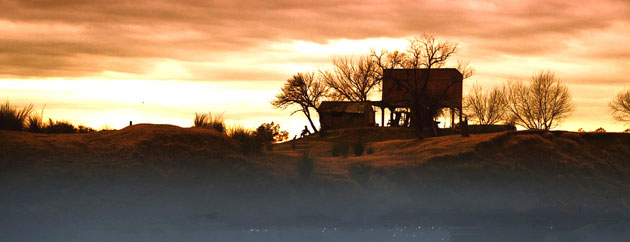
¡Vivan las Antipodas!
31 May, 2012¡Vivan las Antipodas! is a documentary based around the existence of antipodes, or places on the Earth’s surface which diametrically oppose each other through the centre. This seems like something of a shaky premise on which to base a documentary until we are told that, because the majority of the Earth’s surface is covered in water, we are left with only a handful of inhabited pairs. These still seem like arbitrary relationships however, and for the most part they really are, but the film attempts to draw them together by the use of clever shooting and a lot of upside-down camera work to bring out hidden comparisons and contrasts.
The first pair to be explored is a small toll bridge in Entre Rios, Argentina and its composite, Shanghai in China. The laid back peasants who man this bridge are the closest thing to characters which we get in the whole film. We watch them maintain the small river crossing and try to remember to charge the users of their bridge for the pleasure. They exchange the odd observation about wildlife and some misogynistic jokes before casting their minds through the centre of the Earth (which they believe to be made of water, because that is what you find when you dig deep enough) to their opposite number, China. It is not clear how staged this conversation is. It could be an effect of them having a documentary crew present, or it could be that tales of digging to China have descended from Europe and the slow pace of their lifestyle allows them to ponder the other side of the world, where everything is drastically different.
Following a car over the ford point, the camera flips 180° vertically and then seeps under the ground to emerge flying down a motorway in busy Shanghai. This looks impressive and is rather disorientating. The images and music hint at a car chase, but your eyes find it difficult to latch onto the shapes which are now unfamiliar while inverted.
“It is China’s turn to rule the world now,” our Argentineans muse.
Also featuring are the remote and cold mountains of Patagonia, Chile which is paired with Lake Baikal in Russia. In both landscapes, domesticated animals are prominent. In Russia, a man shoos a clan of cats, while in Patagonia, farmhands make short work of a flock of sheepskins.
The film flits backwards and forwards between all the antipode pairs, with attempts at artistic montage and aesthetic flair, but some are more successful than others. Slowly flowing lava in Hawaii turns into the large grey flank of an elephant in Botswana; a beached whale in New Zealand has its tail removed by chainsaw before morphing into a whale-shaped rock in Spain; the Argentinean bridge becomes a massive element-defying piece of Chinese construction.
The world-spanning concept has allowed the director, Victor Kossakovsky, to make footage look original quite simply by turning images upside-down or onto their sides. This reduces whole mountain ranges and beaches into simple stripes of colour which are supposed to let our minds wonder freely around the globe while we listen to the eclectic soundtrack.
In this way the film tries really hard to be like the 1982 film, Koyaanisqatsi. The sleepy villages are contrasted with the manic pace of urban life, and the stillness of nature is interrupted by the crescendos of the soundtrack. The problem is that even though ¡Vivan las Antipodas! has some truly beautifully shot sequences, its lack of a narrative, or characters, or (arguably) any real point or direction means that most of the film simply drags, and some of the images, which could have been mesmerising, are left as underwhelming. Koyaanisqatsi, on the other hand, is brilliant because, despite its loose style, still manages to have a weird kind of plot and even a conclusion, and Philip Glass’ united music score helps with this. For example, where Koyaanisqatsi’s music is constructed like an orchestral piece with movements and a refrain, this film’s depiction of a row of ruined houses in Shanghai is layered over with a particularly jarring piece of accordion music; this easy conceptual conflict almost makes me feel like they have trivialised the wretched lives of some for a cheap effect.
The arbitrariness of the antipodes concept could have been used to highlight areas of the globe which are not usually given much airtime, but unfortunately this chance was wasted. Admittedly, some of the countries are depicted in an unrecognisable way but the clichés — like an elephant-infested Africa, a lava-spewing Hawaii, and the simple peasants of Argentina, Chile and the centre of Russia — are also way too pervasive.
Perhaps the film would’ve been better billed as a piece of artistic cinema rather than as a documentary. It is certainly well shot, with some clever techniques and definitely looks impressive, it just doesn’t really attempt to inform or instruct anyone about anything. The one thing it might be able to teach us is that planet Earth is a very beautiful and varied place. But this is something which we probably knew already.
¡Vivan las Antipodas! is showing as part of Sheffield Doc/Fest from the 13-17 June. More information and screening times can be found here.
Follow Sounds and Colours: Facebook / Twitter / Instagram / Mixcloud / Soundcloud / Bandcamp
Subscribe to the Sounds and Colours Newsletter for regular updates, news and competitions bringing the best of Latin American culture direct to your Inbox.

